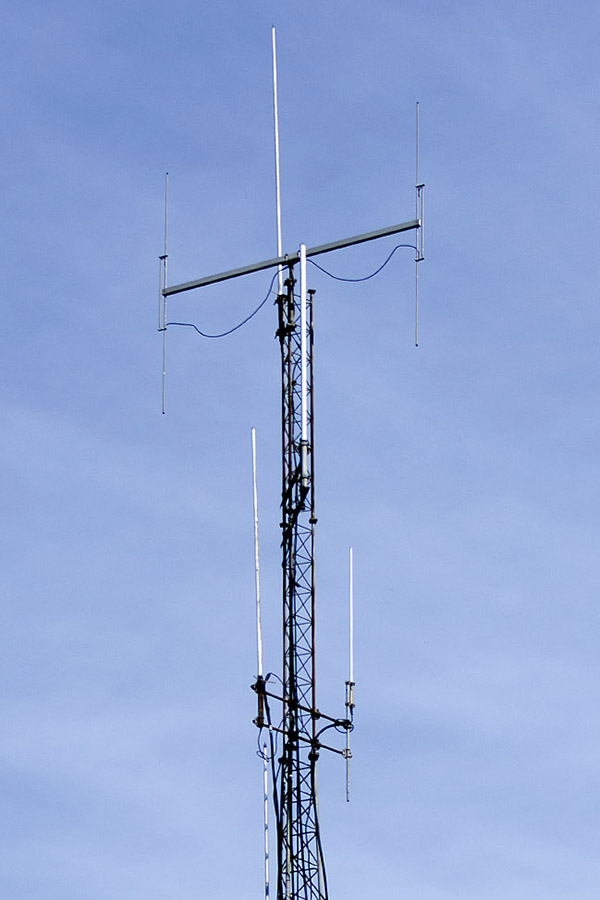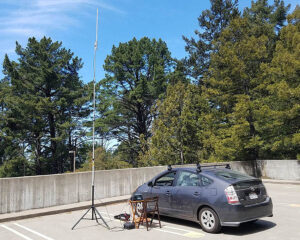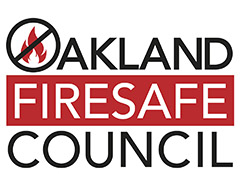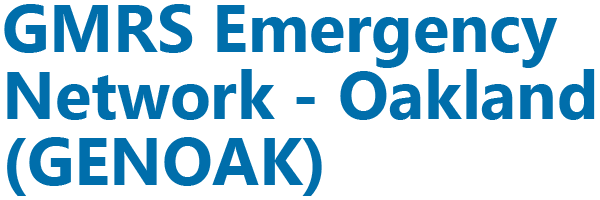GENOAK GMRS Repeater
Repeater Operation

A repeater simply re-transmits (“repeats”) a 2-way radio transmission, typically at a higher power and through an elevated antenna. This allows anyone who can reach the repeater with their radio to talk to anyone else who can also reach the repeater, even if the two radios are too far apart to directly communicate with each other. It also enables 2-way radios to better communicate around or through obstacles such as terrain, infrastructure and foliage that may block direct radio-to-radio signals as depicted above.
Using a repeater requires a 2-way radio that is “repeater-capable.” GMRS radios noted here are all repeater-capable and will work with the GENOAK repeater when the radio is properly configured. Contact us for help configuring your repeater-capable GMRS radio to work with GENOAK.
For direct radio-to-radio (called “simplex”) transmissions, for example if the GENOAK repeater is not reachable or is down, radio communications may take place on GMRS Channel 16 (462.575 MHz) or any other available channel that does not have heavy use.
Click Here for More Detailed Information on Repeaters
About Split Frequencies
In basic “simplex” communications (direct radio-to-radio), the same frequency on a particular channel is used for transmit and receive, meaning that the radio listens on a specific frequency, and when the operator pushes the PTT (Push-To-Talk) button, it transmits on that same frequency.
When communicating with a repeater, two frequencies are used on the radio’s repeater channel. When transmitting, the radio automatically shifts its output frequency by an “offset” amount. That becomes the repeater input. The repeater then re-transmits the message back out, usually at a higher power, at the base frequency, which the radio hears. Without these split frequencies the repeater would not be able to receive and re-transmit at the same time.
As an example, for GENOAK, the 2-way radio listens on 462.600 MHz. When the user pushes the PTT button and transmits, the radio automatically adds +5.000 MHz (positive offset) and transmits the message at 467.600 MHz. The repeater listens on 467.600 MHz. It hears the transmission and re-transmits it (at higher power) back out at 462.600 MHz, which the radio, and thus the user, hears.
Some (but not all) GMRS radios denote the repeater channel that GENOAK uses as Channel 17R. Note that 462.600 MHz (the repeater output frequency) is also a GMRS simplex frequency, noted on many radios as Channel 17 (without the “R”). And there are often other simplex operators using Channel 17. So how does the GENOAK radio and repeater know how to ignore those other radios? That’s where CTCSS/PL tones and DCS codes come in.
About CTCSS/PL Tones and DCS Codes
Most 2-way GMRS radios can be configured to include a sub-audible “tone” or digital code that is added to the transmission. They can also be configured to only receive signals that include that same sub-audible tone or code, and ignore everything else. These are called CTCSS/PL tones and DCS codes.
The repeater as well can include the same tone or code on its output, allowing receiving radios to ignore other signals that don’t come from the repeater. And, repeaters can be configured to only re-transmit signals that include a specific tone or code, and ignore everything else.
CTCSS stands for “Continuous Tone-Coded Squelch System”, commonly known as “PL Tones” from the Motorola trademark “Private Line”. That’s a misnomer, as discussed below. CTCSS/PL tones are sub-audible (below the range of human hearing), usually between 67 and 257 Hz. Even though we can’t hear them, the repeater and radio can, and can “open the squelch” (hear the transmission) when the proper tone is present. Again, this allows the repeater to only repeat signals with the proper tone, and receiving radios to only hear signals that include the proper tone.
DCS (Digital Code Squelch) codes are a similar concept to CTCSS/PL tones, except that a binary data stream is passed as sub-audible data along with the transmission. It serves the same purpose to filter out unwanted transmissions and receptions.
CTCSS/PL tones and DCS codes can be confusing since they are often marketed as “privacy codes.” But adding a tone to your transmission doesn’t actually prevent others from hearing your transmission. Rather, it allows others to filter out other signals if they wish to, and only hear your signal. Anyone can configure their radio to not filter for tones on receive (setting PL to 0 or “Off”), in which case they will hear ALL transmissions on that frequency, regardless of whether or not they include a tone or code. No GMRS transmissions are truly private.
A great reference on demystifying CTCSS/PL tones and DCS codes can be found here.
Oakland GMRS Repeater
GENOAK utilizes the Oakland 600 GMRS repeater operated by the Northern California GMRS Users Group (NCGUG). This Oakland 600 repeater is installed in a hardened building and equipped with a backup battery system that provides three to four days of operation during loss of utility power. Generator backup is also available for longer power outages.
The repeater covers Oakland, Alameda, Emeryville, Berkeley and most other Bay Area cities between Fremont north to Richmond. It is located at 1500 ft. elevation in the Oakland Hills, about 1 mile southeast of the Caldecott Tunnel.

GENOAK Backup Repeater
GENOAK also maintains a mobile, backup GMRS repeater that can be setup if the Oakland 600 GMRS repeater is no longer functioning. This backup repeater operates on the same channel and with the same configuration, so GENOAK-configured 2-way radios will continue to work as before. Depending on where the backup repeater can be located, coverage may be reduced, but many Oakland operators should still have access to GENOAK (although more simplex relays may be needed.)


